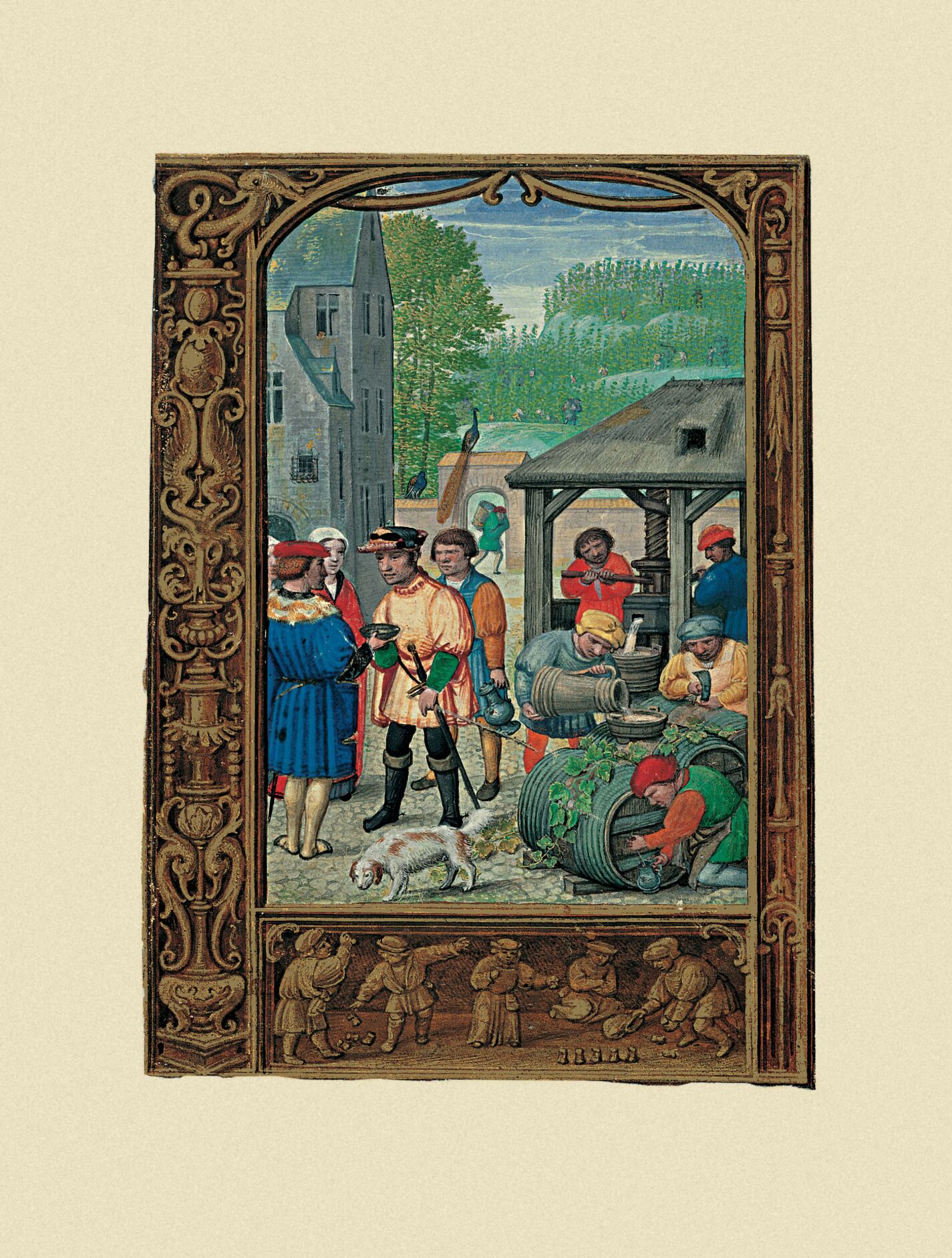The entire scene is filled with different tasks related to the grape harvest on a lord’s estate. One nobleman next to his residence offers another a bowl of the wine obtained from his harvest whilst a woman, a lady and a servant holding a pitcher in his hand look on. Beside them are servants carrying out different tasks: filling a barrel with the grape juice flowing from the screw press turned by two peasants; sealing the casks, well-decorated with vine leaves, with a hammer or hatchet; collecting juice for tasting and wine in a barrel, as shown by one of the servants, with a dog beside him, kneeling with a small pitcher in his hand; and, as can be seen in the mid-ground, grape picking, as shown by a man with a large basket or qualus on his back coming through the entrance arch of the stately house crowned by a peacock. The harvest is set in the mountainous landscape in the background, shown in a fine aerial perspective.
Rarely depicted in French and Italian cycles, the screw grape press – whose mechanism is described in detail in St Isidore’s Etymologiae – had forerunners in the literature of Carolingian and early medieval times and appears in works other than menologies, such as the beatus codices. The decanting of wine on the other hand has more forerunners in art: this task is usually located in October – possibly because of the influence of the poems and miniatures of the Carolingian school of Salzburg, originally included in the French and Italian cycles – where it occupies more than two thirds of the Romanesque cycles, well into the 12th century, and half the Gothic cycles. It appears in thirty-two percent of calendars in France and Italy. The peasant is depicted in them using a funnel to pour wine from a container into a cask. Five calendars, including three Italian ones, from the 12th and 13th centuries depict wine tasting. Wine was drunk shortly after being transferred to vats, possibly because of the conservation problems involved. Although viticulture techniques were adequate, those of viniculture were poor. Medieval grape growers were unable to produce wine that kept well because of inadequate handling.
Carlos Miranda García-Tejedor
Doctor in History

The entire scene is filled with different tasks related to the grape harvest on a lord’s estate. One nobleman next to his residence offers another a bowl of the wine obtained from his harvest whilst a woman, a lady and a servant holding a pitcher in his hand look on. Beside them are servants carrying out different tasks: filling a barrel with the grape juice flowing from the screw press turned by two peasants; sealing the casks, well-decorated with vine leaves, with a hammer or hatchet; collecting juice for tasting and wine in a barrel, as shown by one of the servants, with a dog beside him, kneeling with a small pitcher in his hand; and, as can be seen in the mid-ground, grape picking, as shown by a man with a large basket or qualus on his back coming through the entrance arch of the stately house crowned by a peacock. The harvest is set in the mountainous landscape in the background, shown in a fine aerial perspective.
Rarely depicted in French and Italian cycles, the screw grape press – whose mechanism is described in detail in St Isidore’s Etymologiae – had forerunners in the literature of Carolingian and early medieval times and appears in works other than menologies, such as the beatus codices. The decanting of wine on the other hand has more forerunners in art: this task is usually located in October – possibly because of the influence of the poems and miniatures of the Carolingian school of Salzburg, originally included in the French and Italian cycles – where it occupies more than two thirds of the Romanesque cycles, well into the 12th century, and half the Gothic cycles. It appears in thirty-two percent of calendars in France and Italy. The peasant is depicted in them using a funnel to pour wine from a container into a cask. Five calendars, including three Italian ones, from the 12th and 13th centuries depict wine tasting. Wine was drunk shortly after being transferred to vats, possibly because of the conservation problems involved. Although viticulture techniques were adequate, those of viniculture were poor. Medieval grape growers were unable to produce wine that kept well because of inadequate handling.
Carlos Miranda García-Tejedor
Doctor in History